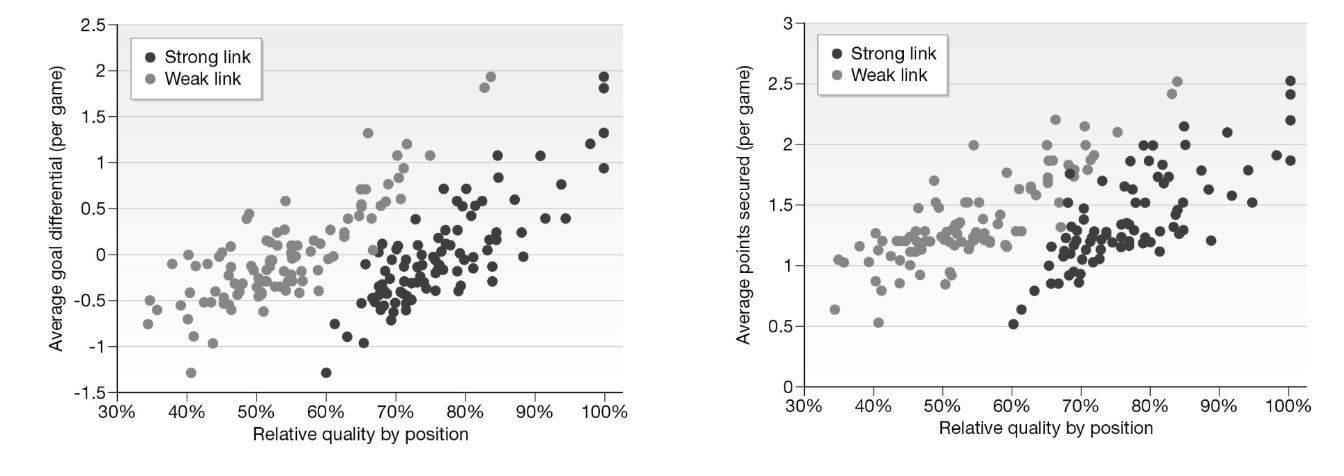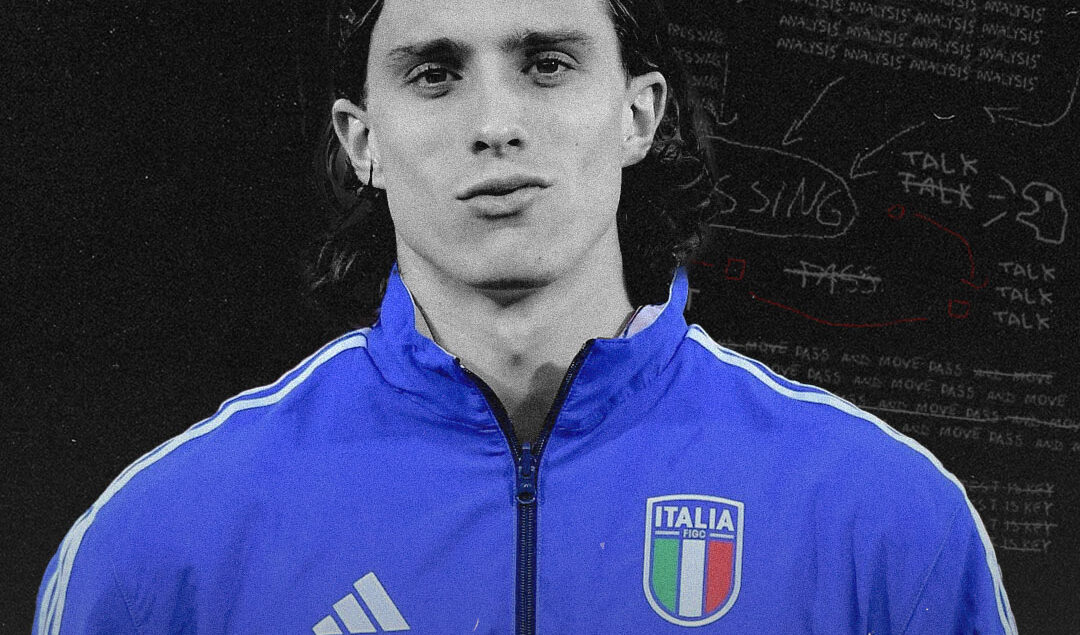Breaking the Mold: Position of the Season 2023/24: Part Three
Weak Link Games: Arsenal’s Search for a Left-sided Defender
Statistically speaking, Arsenal had the Premier League’s best defense in 2023/24. Mikel Arteta’s side only conceded 29 goals in 38 matches, five fewer than the league’s next best defense, Manchester City. So, why has their marquee signing of the 2024 transfer window been Italian central defender Riccardo Calafiori? The 2023/24 position of the season, modern centerbacks, helps answer this question.
For much of the year, Arsenal struggled to find the optimal personnel grouping to play in the defensive line of their hybrid back four/back three in-possession system. Examining these struggles using the “weak link/strong link” theory of games sheds light on the potential rationale behind Arsenal prioritizing the signing of Calafiori.
Disquiet on the left flank
Three of the four positions in Arsenal’s back four were stable over the course of last season, but both injury and lack of form hampered the left side of the Gunners’ defense for much of the year. Arsenal signed Dutchman Jurrien Timber from Ajax Amsterdam for £38 million last summer. While he had played the bulk of games for his former club at centerback, he started his first two games in London playing as a left fullback/outside centerback in Arsenal’s hybrid back four/back three possession set-up.
Unfortunately, Timber’s debut season in the Premier League ended after only 50 minutes when he suffered an ACL injury on matchday one that would keep him out until the last day of the 23/24 season. From that point on, Arsenal lacked strong left-sided defensive options. Oleksandr Zinchenko returned to the starting lineup for much of the first half of Arsenal’s season in Timber’s stead.
Zinchenko, while a regular starter throughout the previous season, excels playing as an inverted fullback when in possession, and has a very different skillset to that of Timber. Most significantly, Zinchenko’s limitations as a 1v1 defender have become a persistent liability for Arsenal in recent seasons. Arsenal’s 1-1 draw with Liverpool at Anfield last December highlighted this fact.
The Gunners took an early lead via a free kick headed home by centerback Gabriel Magalhães. Just before the half-hour mark, however, Liverpool pulled themselves back into the game via a goal by forward Mohamed Salah. After running onto a long pass played in behind Arsenal’s defense, Salah found himself isolated 1v1 against Zinchenko on Arsenal’s left flank.
Salah drove into the Arsenal box as Zinchenko backpedaled feverishly in defense. Zinchenko’s frantic retreat did little to put off the Liverpool striker who calmly shifted the ball onto his left foot before powering a shot beyond Arsenal goalkeeper David Raya at his near post. Salah’s strike at Anfield was the beginning of a torrid run for Zinchenko as he’d be partly at fault for the first goal Arsenal conceded in a 2-0 home loss to West Ham on the next matchday. Zinckenko would then miss the next several matchdays due to the combined effects of a calf injury and poor form.
As a result of Zinchenko’s absence, Jakub Kiwior found himself starting as Arsenal’s left-sided defender for a brief spell from January to April in early 2024. Another centerback shoehorned into a hybrid outside centerback role, Kiwior was a more conservative option than Zinchenko on the left side of defense. However, the Kiwior experiment ended abruptly during Arsenal’s Champions League quarter-final home leg against Bayern Munich.
Bayern winger Leroy Sane regularly exposed Kiwior’s defensive weakness 1v1 in wide areas throughout the first half of the match, most notably in the lead up to a penalty won by Sane and converted by Harry Kane to give Bayern a 2-1 lead going into halftime. As the first half wore on, Kiwior looked increasingly like a player both out of position and out of his depth. Moreover, his shortcomings made Arsenal’s broader approach to the game ineffective.
Arsenal set up to advance Ben White down the right flank in support of Bukayo Saka, leaving William Saliba, Magalhães, and Kiwior as a de facto back three. White and Saka’s combination play proved effective, leading to Arsenal’s opener scored by Saka. But Kiwior’s struggles containing Sane often left Arsenal’s defense vulnerable to Bayern on the counter.
Arteta opted to bring on Zinchenko for Kiwior at half-time and completely altered Arsenal’s build up approach. In the second half, White played in a much more conservative role, sitting back as part of the in-possession back three while Zinchenko inverted into midfield (see Figure 1).
Figure 1.) Arsenal build-up structure first half and second half vs Bayern*

*Ben White highlighted in blue, Kiwior and Zinchenko highlighted in yellow
Left-sided defense was Arsenal’s problem position for most of the 2023/24 season, and the adjustments Arteta and his staff were forced to make during their home leg against Bayern underscore how issues defending the left flank had cascading impacts throughout the team. Successful implementation of these in vogue pseudo back three possession systems is predicated on employing outside centerbacks who excel at defending 1v1 duels to suppress counter attacks.
So, while much has been made of Arsenal lacking a true striker or number 9 to lead their offensive line, there is plenty of evidence to suggest that left-sided defense is a position of similar need for the Gunners. Bearing Arsenal’s season in mind, there is a decade-old assertion about how to improve squads year-on-year that further substantiates Arsenal’s transfer approach this summer.
Arsenal’s “Numbers Game” in summer ‘24
Weak link/Strong link theory of team sports is a concept proposed by economists Chris Anderson and David Sally in their 2013 book “The Numbers Game: Why Everything You Know About Football is Wrong”. The theory suggests that team sports fall within a spectrum of strong link games, where team success is determined primarily by a team’s best player, and weak link games, where a team’s success is driven mainly by the performance of their worst player.
Their work suggests that basketball is the most strong-link driven of the major team sports, while football (soccer) is the most weak-link driven. Anderson and Sally test their theory of football being a weak link sport by comparing data from the 2011-2012 Castrol Player Index with teams’ goal differentials and points totals from that season to see if a team’s performance was more directly correlated to the strength of their weakest* player than the strength of their strongest player (see Figure 2).
Their findings support the assertion that football is a weak link game, as both the goal differential and points total of teams across Europe’s top 5 leagues were more heavily driven by strength of their weak links than their strong links during the 2010-2011 season. Based on these findings, Anderson and Sally suggest teams should focus on strengthening their weak links to generate the most improvement in overall performance year-on-year.
Figure 2.) Effect of top-ranked** and eleventh-ranked players on average goal differential and points total for European clubs, 2010/11

*Weak link defined as a team’s 11th best player in 2010/11 Castrol Player Index
**Goalkeepers excluded from top position
(Anderson and Sally, 217)
Eleven years on from Anderson and Sally publishing their analysis, the Castrol Player Index no longer exists. However, there are several comparable ranking data sources that can serve as a basis for a similar thought experiment around how Arsenal could go about improving on their 23/24 performance in 24/25. WhoScored.com collects average player rankings for the various European competitions over a given season.
Looking at Arsenal’s player ranking data further substantiates the rationale behind strengthening on the left side of defense. Zinchenko had the lowest absolute ranking of Arsenal’s regular outfield starters over the course of the 23/24 Premier League season and third lowest when normalized by position (to account for the fact that attackers tend to have structurally higher ratings on average than defenders).
Kiwior and Takehiro Tomiyasu, who deputized for Zinchenko at various points throughout the season, had even lower average rankings than Zinchenko did, further emphasizing left-sided defense as one of Arsenal’s positional weak links.
Enter: Riccardo Calafiori
Arsenal’s 45 million euro signing of Riccardo Calafiori ticks many of the boxes needed to help improve on the Gunners’ 23/24 defensive weak links. His meteoric rise to stardom at Serie A side Bologna FC 1909 last season came while playing as a centerback under coach Thiago Motta. Before joining Bologna, however, Calafiori had played regularly as a left fullback. Calafiori’s versatility and variety of experience are reminiscent of other centerbacks who have been able to thrive in the hybrid centerback/fullback role he will likely play at Arsenal, including Arsenal’s own Ben White as well as City’s Nathan Ake and Manuel Akanji.
Motta’s Bologna played a fluid brand of attacking football where centerbacks regularly pushed into midfield and attack as players continually rotated in and out of positions across the field. Such a dynamic system gave Calafiori the ideal platform to showcase his attacking prowess. He was in the 99th percentile among centerbacks for assists per 90 minutes and the 96th percentile in terms of shot-creating actions in the last year (FBRef).
In addition to his array of attacking talents, Calafiori brings a defensive skill set sorely missed on Arsenal’s left flank in 23/24, ranking in the 96th percentile among centerbacks in interceptions per 90 in the last year and excelling in defensive ground duels. Calafiori’s appearance and playing style have drawn comparisons to Italian national team legend Paolo Maldini, but as the young Italian strode into attacking positions regularly throughout last season, one could not help but see the vestiges of Franz Beckenbauer in his play as well.
What Arsenal lacked last season, in the absence of Timber, was a left-sided defender suited to the varied tasks expected of modern hybrid defenders. Calafiori has demonstrated the ability to serve as an improvement on both Zinchenko and Kiwior in this respect. Adding Calafiori to Arsenal’s rotation gives Arteta a more balanced left-sided defensive option who can go forward with potency similar to that of Zinchenko while maintaining greater defensive solidity.
As more of an all-rounder defender rather than a specialist fulllback or centerback, Calafiori fits the mold of centerback that top sides in the Premier eagues (including Manchester City) are increasingly looking for. Seemingly a perfect fit and a panacea to Arsenal’s defensive woes, it will be interesting to watch how Calafiori adjusts to his new surroundings at the Emirates, particularly given that Arsenal’s system is slightly more rigid in structure than the positionally fluid system he played in at Bologna last season.
Regardless of any growing pains he experiences integrating at Arsenal, Calafiori’s signing epitomizes the current trend in centerback profiling in England’s top-flight. Traditional positional distinctions are being broken down across teams’ defensive lines, new roles are being defined, and multifaceted centerbacks who can adapt to a broader set of positional expectations are finding themselves in high demand.
By: Ade Samuel / Linkedin: https://www.linkedin.com/in/ade-samuel-42a165172/
Featured Image: @GabFoligno / Alessandro Sabattini / Getty Images
